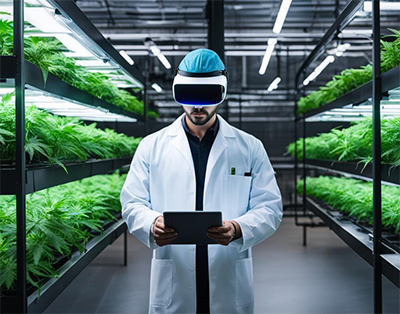The cannabis industry is undergoing a transformation, driven by technological advancements that are reshaping how cannabis is cultivated, processed, and consumed. As cannabis legalization continues to spread globally, the cannabis market is projected to grow exponentially, with technology playing a pivotal role in this expansion. Let’s into the future of cannabis technology, and explore innovations that are set to revolutionize the industry, from cultivation to consumer experience.
Precision Cultivation: The Rise of Smart Growing Techniques
 As cannabis cultivation scales up to meet rising demand, precision agriculture is becoming essential. Smart growing techniques, powered by the Internet of Things (IoT), artificial intelligence (AI), and machine learning, are optimizing every aspect of cannabis farming.
As cannabis cultivation scales up to meet rising demand, precision agriculture is becoming essential. Smart growing techniques, powered by the Internet of Things (IoT), artificial intelligence (AI), and machine learning, are optimizing every aspect of cannabis farming.
IoT and Data-Driven Farming
IoT devices, including sensors and automated systems, are being used to monitor and control environmental factors such as temperature, humidity, light, and soil moisture. These devices collect real-time data, allowing growers to adjust conditions to optimize plant growth. This level of precision reduces resource waste and ensures that plants receive the exact conditions they need to thrive.
Artificial Intelligence in Cannabis Cultivation
AI is being integrated into cannabis cultivation through predictive analytics and machine learning algorithms. These technologies can analyze vast amounts of data from IoT sensors and historical crop data to predict potential issues, such as pest infestations or nutrient deficiencies, before they become problems. AI-driven systems can also optimize planting schedules, irrigation, and nutrient delivery, maximizing yields and quality.
Automated Growing Systems
Automation is another key trend in cannabis cultivation. Automated growing systems, such as vertical farming setups and robotic harvesters, are reducing the need for manual labor and increasing efficiency. These systems are particularly beneficial in indoor and greenhouse settings, where they can be programmed to maintain optimal conditions around the clock.
Cannabis Processing: Innovations in Extraction and Manufacturing
The processing stage of cannabis production is also seeing significant technological advancements, particularly in extraction methods and product manufacturing.
Advanced Extraction Techniques
Extraction is a critical process in creating cannabis products like oils, edibles, and concentrates. Traditional extraction methods often involve solvents like butane or ethanol, which can leave behind residual chemicals and impact product purity. However, new technologies are emerging that offer cleaner and more efficient extraction processes.
Supercritical CO2 extraction, for example, uses carbon dioxide in a supercritical state to extract cannabinoids and terpenes from the cannabis plant. This method is not only safer but also produces a purer product with a higher yield. Additionally, innovations in solventless extraction, such as rosin presses and ice water extraction, are gaining popularity for producing high-quality concentrates without the use of chemicals.
Nanotechnology in Cannabis Products
Nanotechnology is poised to revolutionize cannabis product manufacturing by improving bioavailability and onset times. Nanoemulsion techniques break down cannabinoids into tiny, water-soluble particles, allowing them to be absorbed more quickly and efficiently by the body. This technology is particularly impactful in the development of edibles, beverages, and topicals, where faster onset times and consistent dosing are crucial for consumer satisfaction.
3D Printing of Cannabis Products
The advent of 3D printing technology is opening new possibilities for personalized cannabis products. Companies are exploring the use of 3D printers to create customized edibles and capsules with precise dosages tailored to individual needs. This level of customization could appeal to medical cannabis users who require specific cannabinoid ratios for their conditions, as well as recreational users looking for a more controlled experience.
Consumer Experience: Enhancing Accessibility and Personalization
 As the cannabis market becomes more competitive, companies are focusing on enhancing the consumer experience through technology. This includes innovations in product delivery, personalized recommendations, and virtual reality (VR) experiences.
As the cannabis market becomes more competitive, companies are focusing on enhancing the consumer experience through technology. This includes innovations in product delivery, personalized recommendations, and virtual reality (VR) experiences.
Cannabis E-Commerce and Delivery Services
The convenience of online shopping has extended to the cannabis industry, with e-commerce platforms and delivery services becoming increasingly popular. These platforms use algorithms to offer personalized product recommendations based on user preferences and purchase history. Additionally, advancements in logistics and delivery technology, such as drone delivery and autonomous vehicles, could further streamline the process, making it easier for consumers to access cannabis products.
Personalized Cannabis Experiences
AI-powered apps and devices are enabling more personalized cannabis experiences. For instance, wearable devices that track biometrics like heart rate and sleep patterns can be used in conjunction with AI to recommend specific cannabis strains or products that match an individual’s needs. Similarly, AI-driven platforms are providing users with tailored product suggestions based on their desired effects, such as relaxation, creativity, or focus.
Virtual Reality and Augmented Reality
VR and AR are emerging as powerful tools for both consumers and businesses in the cannabis industry. VR can create immersive experiences that allow users to explore cannabis farms, dispensaries, or product manufacturing processes from the comfort of their homes. This technology can also be used for educational purposes, helping consumers learn about different strains, consumption methods, and the effects of cannabis in an engaging and interactive way.
AR, on the other hand, is enhancing the in-store shopping experience. AR apps can provide detailed information about products when a user points their smartphone at them, offering insights into cannabinoid content, effects, and reviews. This technology not only educates consumers but also helps them make informed purchasing decisions.
Compliance and Security: Safeguarding the Future of Cannabis
As the cannabis industry grows, so do the challenges related to compliance and security. Technology is playing a crucial role in ensuring that cannabis businesses operate within legal frameworks and protect their products and data.
Blockchain for Transparency and Traceability
Blockchain technology is being adopted in the cannabis industry to enhance transparency and traceability throughout the supply chain. Blockchain provides an immutable ledger that records every transaction, from seed to sale, ensuring that products are tracked at every stage of the production process. This technology can help prevent issues such as product tampering, counterfeiting, and regulatory non-compliance by providing verifiable data to both regulators and consumers.
Compliance Management Software
As cannabis regulations vary widely between regions, businesses need to navigate a complex legal landscape. Compliance management software is helping companies stay compliant by automating the tracking of regulatory requirements and generating reports for audits. These platforms can also monitor changes in legislation and update business practices accordingly, reducing the risk of non-compliance.
Cybersecurity in the Cannabis Industry
With the increasing digitization of the cannabis industry, cybersecurity is becoming a top priority. Cannabis businesses are prime targets for cyberattacks due to the high value of their products and data. To protect against these threats, companies are investing in advanced cybersecurity measures, including encryption, multi-factor authentication, and regular security audits. Additionally, secure payment processing systems are being implemented to protect consumer information during transactions.
The Role of Artificial Intelligence and Big Data in Cannabis Research
 AI and big data are revolutionizing cannabis research, enabling scientists to uncover new insights into the plant’s properties and potential applications.
AI and big data are revolutionizing cannabis research, enabling scientists to uncover new insights into the plant’s properties and potential applications.
Cannabinoid Research and Product Development
AI algorithms are being used to analyze vast amounts of data from cannabis research studies, patient reports, and genetic profiles. This analysis is helping researchers identify new cannabinoids, understand their effects, and develop novel cannabis products. For example, AI can predict how different cannabinoid combinations might interact with the body, leading to the creation of targeted therapies or recreational products with specific effects.
Genomic Research and Plant Breeding
Big data and AI are also accelerating genomic research and plant breeding in the cannabis industry. By analyzing the genetic makeup of cannabis strains, researchers can identify traits associated with desirable characteristics, such as higher cannabinoid content, disease resistance, or faster growth. This information can be used to develop new strains with optimized properties, improving the efficiency and profitability of cannabis cultivation.
The Future of Cannabis Technology: Challenges and Opportunities
While the future of cannabis technology is full of promise, it also presents challenges that need to be addressed.
Regulatory Hurdles
As cannabis technology advances, regulatory frameworks must evolve to keep pace. Governments and regulatory bodies will need to adapt their policies to accommodate new technologies, such as blockchain, AI, and nanotechnology, while ensuring that safety and quality standards are maintained.
Investment in Research and Development
Continued investment in research and development is crucial for driving innovation in the cannabis industry. However, securing funding can be challenging due to the legal status of cannabis in many regions. As legalization expands, increased funding opportunities will be essential for supporting technological advancements.
Public Perception and Education
The success of new cannabis technologies also depends on public perception and education. Consumers and stakeholders need to be informed about the benefits and potential risks of these technologies to build trust and acceptance. Educational initiatives, both online and in-person, will play a key role in achieving this.
Conclusion
The future of cannabis technology is bright, with innovations poised to transform every aspect of the industry. From precision cultivation and advanced extraction techniques to personalized consumer experiences and enhanced compliance, technology is driving the cannabis industry forward. As these advancements continue to unfold, they will not only improve the quality and accessibility of cannabis products but also ensure the industry’s long-term sustainability and success.
By staying at the forefront of these technological trends, cannabis businesses can position themselves for growth and innovation in a rapidly evolving market. The future of cannabis technology is not just about keeping up with change; it’s about leading the way into a new era of possibilities.

